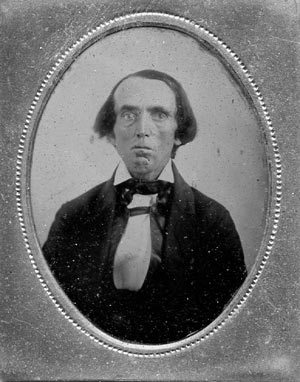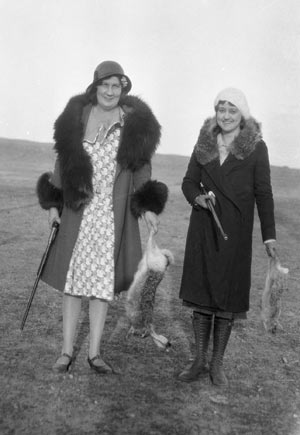
Who are these people? What is this place? If I had a dime for every time I’ve asked those questions in the last week, I’d be well-set financially.
That’s because I’ve been sorting through family photographs going back 150 years or so. The idea is to scan them into the computer, where they can be printed as wanted and where I can burn them to CD or DVD to send to other family members. Some of the pictures have grown very fragile with time, so this may be the last opportunity to save them.
Problem is, the person taking the pictures (or having them taken, in the case of some of the old tin-types and studio pictures) knew who or what was depicted. So that person felt no need to make any note on, say, the back of the picture. Now, decades later, we have no idea who anyone is, where they were, or what they were doing.
 |
|
Who is he? |
I’ll see a picture of some adults with a child. By looking at other pictures, it becomes possible to guess who one of the persons is; over time, and through a few hundred more pictures, the identities of all can be ascertained or close to it. Some knowledge of the relative ages of the persons depicted helps: what looks like my father cannot be my father because someone else in the picture died before he was born. So who is it?
This would be a fine parlor game if I did not have thousands of pictures to deal with. Nor does this identification by association always work. My dad took a lot of news pictures over a 50-year career that extended from the 1910s to the 1960s. With no caption information a picture of possible historical significance becomes just about useless. Who is this black man, being led away in shackles, as an apparently unsympathetic crowd looks on? What is this other huge crowd, gathered at night and illuminated by a powerful flash bulb, from what seems to be the 1930s?
Who is this fellow who seems to be slaughtering thousands of — what? Turkeys? Geese? Was this a story about the horrible conditions in which poultry was prepared? Or was it a feature about dinner for some upcoming holiday?
My maternal grandfather was methodical. He realized that the pictures of old family places and events would outlive him. He wrote the names of people on the backs of pictures of them, or typed a description of the scene and kept it with the picture. Thanks, Grampa!
In the course of all this scanning and puzzling over pictures I’ve come to realize that we’re not as bad today. We’re worse. In the old days it was at least possible to provide a caption in pencil (ink bleeds) on the back of the picture. But modern photography more often than not produces digital pictures that rarely become physical pictures. Because we no longer have to pay for film and processing, we take more pictures than ever. Some are even good and worth keeping. But from the instant the shutter is pressed, they begin their march into obscurity.
 |
|
Who is are these people? |
Actually, it is possible to store comments with digital pictures, but it is not easy. Every time you take a digital picture (or I scan in a picture), data are stored with it. These “EXIF” data include exposure information, the time and date the picture was taken, on some very modern cameras even the location — they have built-in GPS. There is also — bet you didn’t know this — a “comments” field. The comments field is blank, usually, because there’s no convenient way to add comments. A few cameras allow the photographer to add comments by “typing” them in using the buttons on the back of the camera. Try doing this and you’ll find out why few take advantage of the feature.
The result is that we’re making more and more pictures that, should they survive us, will leave our descendants as puzzled by our pictures as I am by those of my ancestors. It ought to be easier to add captions to the pictures we make, because then we’d be more likely to add those comments.
We can’t do anything about that right now, but we can do something else. This is the time of year when families get together. Why not take an afternoon, drag out the family pictures, and make note of them in pencil on the back, while their contents remain in living memory? Besides performing a useful family function, this can be — always is, in my experience — a lot of fun.
The old cliche is that a picture is worth a thousand words. Sometimes it is. But experience suggests that most of the time a picture without a few words is not good for much.
Dennis E. Powell is crackpot-at-large to Open for Business. Powell was an award-winning reporter in New York and elsewhere before moving to Ohio and becoming a full-time crackpot. You can reach him at dep@drippingwithirony.com.